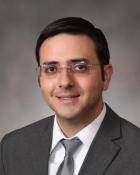Atrial fibrillation, or AFib, is the most common type of irregular heartbeat, or arrhythmia. Without treatment, atrial fibrillation can increase your risk for blood clots, heart failure and stroke. The cardiac experts at UK Gill Heart & Vascular Institute provide specialized care to manage symptoms, prevent complications and improve quality of life for those living with atrial fibrillation in Central Kentucky.
Atrial fibrillation is caused by abnormal electrical activity in the atria, the heart’s upper chambers, which causes the heart to beat irregularly and often too quickly. The unusual electrical signals cause the atria to quiver or fibrillate. They also interfere with coordination between the atria and lower heart chambers, called ventricles. When the atria and ventricles aren’t coordinated, the ventricles don’t fill up with blood and cannot pump blood efficiently to other parts of the body. The disrupted blood flow may cause blood to pool in the heart, which increases the risk of blood clots and stroke.
Atrial fibrillation is classified by how long symptoms last and respond to treatment:
- Paroxysmal: This type of atrial fibrillation typically lasts less than 24 hours but may persist for up to a week. The severity of paroxysmal atrial fibrillation symptoms varies. You may need treatment, or symptoms may resolve on their own. Symptoms can go away and come back.
- Persistent: In this type, symptoms last more than a week but less than a year. Treatment is usually needed to return to a normal heart rhythm.
- Long-term persistent: This atrial fibrillation lasts more than a year, and treatment is necessary.
- Permanent: At this stage, no further efforts will be made to restore normal rhythm. Rate control and anticoagulation medicines are still used.
Learning about atrial fibrillation and taking steps to manage it can help you avoid complications and live an active life. The sooner atrial fibrillation is treated, the better. Treatment is aimed at quality of life and to prevent complications from fast heart beats long term.
You may have one or more of the following symptoms of atrial fibrillation:
- Chest pain or pressure
- Confusion
- Dizziness or lightheadedness
- Extreme tiredness
- Fainting
- Fast, fluttering or pounding heartbeat
- Feeling anxious
- Irregular heartbeat
- Low blood pressure
- Shortness of breath, especially during exercise or when lying down
- Sweating
It’s also possible to have atrial fibrillation without any symptoms.
The most common risk factor for atrial fibrillation is high blood pressure, or hypertension. Other risk factors include:
- Being age 65 or older
- Chronic kidney disease
- Diabetes
- Family history of atrial fibrillation
- Heart disease, including coronary heart disease and heart valve issues
- Heart failure
- Lung diseases, such as chronic obstructive pulmonary disease (COPD)
- Moderate to heavy use of alcohol or binge drinking
- Obesity
- Overactive thyroid or hyperthyroidism
- Participating in endurance sports
- Recent heart or lung surgery
- Significant emotional stress
- Sleep apnea
- Smoking
- Use of some illegal drugs, including cocaine and methamphetamines
People of European descent are more likely than others to develop atrial fibrillation. However, people of African descent have a higher risk of complications due to the condition.
There are several things you can do to help prevent atrial fibrillation and its related complications, such as a stroke. These include:
- Eating a heart-healthy diet
- Exercising regularly
- Managing chronic health conditions and daily stress
- Avoiding excessive substance use (i.e., alcohol, illegal drugs and smoking)
Your first visit to UK Gill Heart & Vascular Institute’s Adult Heart Rhythm Program is a time of education and introductions. You meet members of your care team and learn about detecting, treating and living with arrhythmias.
Diagnosing arrhythmias is a unique process that requires detective work. One of the most important steps toward diagnosis is listening to your story. Your team will ask a lot of questions about your symptoms and medical history. The goal is to gather all possible information that can help pinpoint the source of your heart issue. Information from this first meeting helps your team determine the next step in diagnosis.
Based on information from this meeting, your healthcare provider may give you a monitor to wear. This monitor tracks your heart rhythm and allows your team to determine the type of arrhythmia you have. Additionally, your team may prescribe one or more diagnostic tests. If appropriate, these tests take place on a different day, and your team helps schedule them at your convenience.
When coming to your first arrhythmia appointment, plan to do the following:
- Arrive early. You may need to fill out paperwork when you arrive. Getting to your appointment early ensures you have time to complete paperwork without feeling rushed.
- Bring a current list of medicines or supplements you take. You should also list any surgeries you’ve undergone, symptoms you’ve experienced and other past health issues.
- Dress comfortably. Working toward a diagnosis takes time. Comfortable clothes help you remain relaxed and attentive throughout your visit.
- Eat and drink normally. You won’t undergo imaging or other testing at your first visit. Therefore, there are no dietary restrictions.
- Have your insurance information on hand. UK HealthCare accepts most insurers, and financial assistance is available.
- Request a loved one to join you. Bring a family member or friend with you to take notes and ask questions you may not think of asking.
Where we are located
The UK Gill Heart & Vascular Institute is located at 800 Rose St. in Pavilion G, on the first floor of UK Albert B. Chandler Hospital. We will mail you a map and directions when your appointment is scheduled.
Patient drop-off
Patients can be dropped off in front of the main entrance to Albert B. Chandler Hospital at 1000 S. Limestone. If you are dropped off at the main entrance, you’ll enter the revolving doors on the ground floor of the hospital. Take the main stairs just to the left (or elevator across the atrium) to the first floor of Pavilion A.
After climbing the stairs or taking the elevator, turn left. You’ll pass the Kentucky Wall and Kentucky Children’s Hospital on your right. Continue to the end of the hall until it comes to a T shape. Turn left and the Gill clinic entrance is across from an open area housing the organ donor wall.
Parking
It is easiest to park in the UK HealthCare Parking Garage, across from the hospital at 110 Transcript Ave.
There are two paths from this garage to the Gill clinic:
- You may take the free shuttle from Level A of the parking garage. You’ll exit the shuttle at the Pavilion A/ Pavilion G stop in front of the main entrance to the hospital. After climbing the stairs or taking the elevator, turn left. You’ll pass the Kentucky Wall and Kentucky Children’s Hospital on your right. Continue to the end of the hall until it comes to a T shape. Turn left and the Gill clinic entrance is across from an open area housing the organ donor wall.
- From Level C of the parking garage you may walk or take a golf cart across the pedway to the first floor of Pavilion A. Turn left past the help desk and walk away from the dining hall. You’ll pass the Kentucky Wall and Kentucky Children’s Hospital on your right. Continue to the end of the hall until it comes to a T shape. Turn left and the Gill clinic entrance is across from an open area housing the organ donor wall.
If you need help finding your way, information desks are located inside the main entrances to Pavilion A, both on the ground floor and at the end of the pedway on the first floor. You may also call the information desk at 859-323-5816.
Our Adult Heart Rhythm Program experts help residents of Central Kentucky and beyond regain proper heart rhythm every day. To improve the future of arrhythmia treatment and management, they also participate in clinical trials.
At any given time, UK Gill Heart & Vascular Institute staff engages in trials for new medicines or devices. This gives you access to arrhythmia treatment not available at many other facilities.
If you’re a candidate for an ongoing trial, your care team will discuss the possibility with you.









